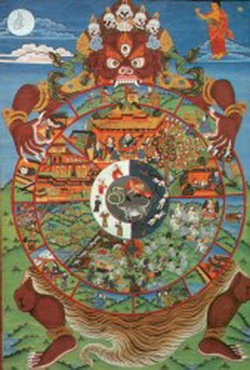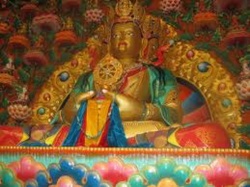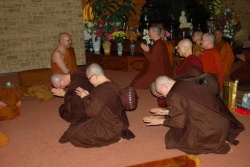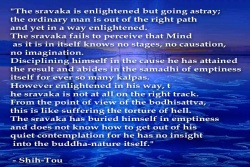Dependent origination
[[Image:Wheel of life.jpg|frame|The Wheel of Life)]
- See also :
- See also :
Dependent Origination (Skt. pratītyasamutpāda; Tib. རྟེན་འབྲེལ་, tendrel; Wyl. rten 'brel) means that all phenomena, outer and inner, do not appear without any causes.
Nor are they caused by a causeless and permanent creator such as the self, time or God.
In fact, they arise through the coming together of their own particular causes and conditions. dependent origination (pratitya-samutpada, shi-er yin-yuan):
Also referred to as dependent co-arising or the “Chain of Conditioned Arising.”
Also referred to as “twelve links’ or nidanas of dependant co-arising or the chain of conditioned arising.
They are ignorance, compositional factors, consciousness, name and form, six senses, contact, feeling, craving, clinging or grasping, becoming, rebirth, and old age and death
- All outer phenomena (ཕྱིའི་ཆོས་, Wyl. phyi'i chos) arise through dependent origination, in the manner of a seed developing into a sprout, for example.
- And all inner phenomena (ནང་གི་ཆོས་, Wyl. nang gi chos)—the aggregates of supreme, intermediate or lesser beings—arise through dependent origination in the manner of the twelve links.
Outer Phenomena—The Example of a Seed
So the dependent origination of all outer phenomena can be understood through the example of a seed developing into a sprout, with seven related causes and six related conditions:
The following seven are the perpetuating causes, the stages of development:
- seed
- sprout
- leaves
- stamen
- stalk
- bud
- flower
The six related conditions are:
- the earth element which supports
- the water element which binds
- the fire element which ripens
- the wind element which expands
- the space element which accommodates
- time which gradually changes
These six act as cooperating conditions and assist in the growth from seed to flower.
Inner Phenomena—The Twelve Links
In the case of inner phenomena, the related causes are the twelve links:
There are several related conditions:
Ignorance, craving and grasping—the three links that are disturbing emotions—arise with the co-operating conditions of the six faculties and their respective objects.
The same conditions assist in the arising of the two links of karma—formations and becoming.
The other seven links, which are known as the ‘bases of suffering’, arise with the assistance of the six elements as co-operating conditions:
- earth element which is solidity
- water element of liquids
- fire element through which digestion occurs
- wind element of the respiratory system
- space element of the body’s cavities
- consciousness
For a consciousness, such as eye consciousness, to occur, five things must come together:
- the support which is the particular sense faculty
- the object
- its actual presence
- unobstructed space
- the intention of apprehension
Five Special Features
The Dependent Origination of causes and effects has five special features:
- The sprout, for example, arises after the seed has ceased and not while the seed is present unceasingly. Phenomena, therefore, are not permanent.
- The sprout does not arise from discontinuance, the seed having ceased completely. The cessation of the seed and the growth of the sprout occur simultaneously like the two sides of a set of scales, or a see-saw: one goes up as the other goes down. Since there is not interruption of the continuum, there is no discontinuance.
- The seed and the sprout are not one in terms of their identity or their function, so the former is not transferred into the latter.
- Wheat seeds produce wheat crops and virtue produces happiness, so there is a correlation between cause and effect: they are of a similar continuum.
How the Links Occur Over Lifetimes
The twelve links can be explained as a process occurring over three lifetimes:
(i) The past cause of ignorance and karmic formations lead to the result of (ii) one’s consciousness of the present life and the links up until becoming, through which one accumulates the karma through the negative emotions of craving and attachment, that will lead to (iii) a future rebirth. One takes birth according to one’s karma and experiences the sufferings of old age and death and so one.
Or over two lifetimes:
(i) The ignorance of one’s previous incarnation, and the karma created through the power of craving and attachment, cause (ii) one to take another birth, and in that present life there arise the links from consciousness through to becoming and old age and death.
The Twelve Links in Actions
It is also shown how the twelve links are complete in a given act:
In the case of killing, for example:
- Ignorance is the ignorance through which one engages in the act.
- The action itself is the karmic formation.
- Then there is the consciousness of that particular time.
- The name-and-form
- And six sense-sources
- Produce the contact with the weapon.
- One’s own pleasure and the pain of the other are sensations.
- Joyfully engaging in that is craving.
- From this comes grasping, which is enthusiasm for similar acts in future.
- The aggregates at the time of the act are becoming.
- Their present and future aspects are birth.
- Their changing is “aging” and conclusion is “death”.
Fourfold Classification
- The three links of ignorance, formation and consciousness are the propelling links.
- The four from name-and-form to sensation are the propelled result.
- The three links of craving, grasping and becoming are the fully establishing links.
- Birth and old age and death are the fully established links.
Karma, Disturbing Emotions and the Bases of Suffering
- The links of formations and becoming are karma.
- The links of ignorance, craving and attachment are disturbing emotions.
- The remaining seven links are the bases of suffering.
Crop Analogy
From the three links of disturbing emotions, the two links of karma arise. And from them, the seven bases of suffering arise. From these seven, further disturbing emotions and karma are created forming a continuous cycle.
From among the twelve links, the two links of karma and the three of disturbing emotions, in addition to consciousness, are the causes that bring about the other links:
- Ignorance
- Karma (including formations and becoming)
- Craving (includes both craving and grasping)
- Consciousness
Consciousness is like a seed. Karma is like a field. Craving is like moisture. Ignorance is like the act of planting and the fertilizer. Through these four the fresh shoots of name-and-form develop in the various states of existence.
Related to the Four Noble Truths
In progressive order, the two links of karma and three of disturbing emotions are included under the truth of origin. And the seven bases of suffering fall under the truth of suffering.
In reverse order, the reversal of the links of karma and disturbing emotions is the truth of the path. And the ceasing of the seven bases of suffering is the truth of cessation.
Alternative Translations
Footnotes
Further Reading
- Mipham Rinpoche, Gateway to Knowledge, vol. I, Rangjung Yeshe Publications, 1997
- The Dalai Lama, The Meaning of Life, Boston: Wisdom Publications, 2000 (Revised edition)
Internal Links
External Links
The Heart of Dependent Origination by Nagarjuna
Dependent origination (rten cing 'brel bar 'byung ba). The natural law that all phenomena arise 'dependent upon' their own causes 'in connection with' their individual conditions. The fact that no phenomena appear without a cause and none are made by an uncaused creator. Everything arises exclusively due to and dependent upon the coincidence of causes and conditions without which they cannot possibly appear.
Dependent origination or conditioned arising (paṭiccasamuppāda) is the Buddhist concept that
(1) nothing is ‘a thing in itself’ but is dependent for its existence on other things and that
(2) things come into being due to natural causation, not randomly or by the will of a supreme being.
To give an example of the first of these concepts – we speak of ‘a flower’ but if, one by one, we remove the stem, the petals, the nectar, the stamens, the pistils, etc, none of which are the flower itself, we find that the ‘flower’ has gone.
A flower is a convenient term for the sum total of its parts and each part is again the sum total of its parts too.
This is true of cities, books, computers, rocks and people. Thus according to the Buddha, there is no permanent metaphysical self, soul or essence.
Realizing this frees us from craving for life and terror of death and all the negative emotions and actions that go with them. Understanding the second of these concepts requires us to look within rather than without for the solution to the problem of individual and social conflict.
The Buddha gives at least three examples of dependent origination, one detailing the origins of the individual’s experience of suffering, another explaining the origins of suffering within the social context and a third detailing the process leading to the transcendence of suffering and the attainment of freedom.
The first is: ignorance conditions mental constructs, mental constructs condition consciousness, consciousness conditions name and form, name and form condition the senses, the senses condition contact, contact conditions feeling, feeling conditions craving, craving conditions clinging, clinging conditions becoming and becoming conditions rebirth, sickness, old age and death (D.II,55).
The second is: conflict is caused by the liked, the liked is caused by desire, desire is caused by pleasant and unpleasant, pleasant and unpleasant is caused by contact, contact is caused by name and form (Sn.862-871).
The third and most important schema of dependent origination is: suffering conditions faith, faith conditions gladness, gladness conditions joy, joy conditions tranquillity, tranquillity conditions happiness, happiness conditions concentration, concentration conditions disenchantment, disenchantment conditions dispassion, dispassion conditions freedom, freedom conditions knowledge of the destruction of the defilements (S.II,30).
The Buddha said: ‘Dependent origination is not just profound but it looks profound too.
It is through not understanding, not penetrating it that humanity is, like a tangled ball of string, a matted bird’s nest, a grass thicket, unable to go beyond suffering, an unhappy destiny and saṃsāra’ (D.II,55).
Causality - The Central Philosophy of Buddhism, David Kalupahana,1975.
See: “pratyekabuddhas,” Maha-Nidana Sutta.








